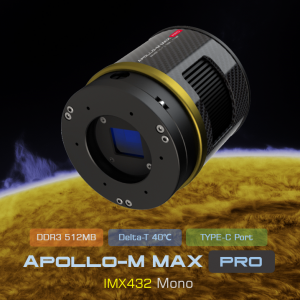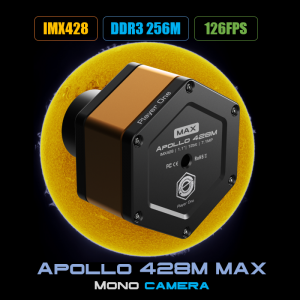TTS-160 Panther Mount Review: Sometimes you just want to do visual and have it as easy as possible. Maybe you’ve had a hard day at the office, or your back’s aching from when you bent over to pick up the dog, or perhaps you just want to see the texture of space in real-time and don’t want to mess with a camera. Whatever.
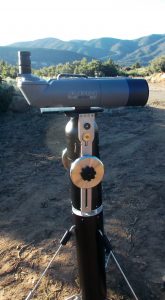
Sometimes uncomplicated visual is the way to go, and the TTS-160 Panther mount is about as easy, accurate and fun a mount for visual as you can find – and it does imaging, too, with no polar alignment necessary (Image 1).
Imagine, an altitude/azimuth (alt/az) mount designed for accurate go-to, simple and quick setup and, if you want, imaging. Be still my beating heart! Coming in specifically designed bags, each piece light enough to carry one-handed, a cool tripod leg/base component, a motorized head like nothing you’ve seen before (sort of R2D2-esque), less weights needed to counter-balance (hey, it’s alt/az), an odd-but-effective hand pad, and good looks, the TTS-160 is a joy to haul and set up and has a carrying capacity up to 50 pounds (22.7 kilograms), while only weighing in at 30 pounds (13.6 kilograms) itself .
First, pull the legs out from inside the pier tube, pier on top, tighten up the extension rods on the legs (that attach to the pier), place the R2D2-like mount head on pier and lock ‘em up. Twin armatures on either side of the mount head allow your counter weights to slip on (balance is just in one direction – Image 2). Pop on the telescope, or, in this case, a pair of 100-mm 90-degree binocs (go-to with big binocs!). Plug in the hand pad, and fire that puppy up.
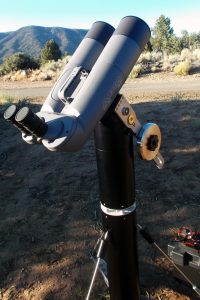
A word on the hand pad (Image 3). It’s not your push-button (0 to 9) with arrows. It’s got a display and three knobs, which you can rotate to dial through the menus and push to select. The knobs also double as controls for manually moving the mount (up and down for one set, side-to-side for the other knob).
In theory, it’s really cool, especially the manual mount control with the knobs. In practice, it’s pretty great, but, it takes a little bit to get used to dialing through and choosing on the menu…in fact, sometimes it’s the tiniest bit trying.
Choosing is fine. Selecting and jumping between items, that’s the sticky-wicket. It’s just different than other hand controllers. Once you figure it out, it’s not hard, but it takes a little bit of practice, because you’re going along fine, then something is counter-intuitive. Again: Not a big deal! Still, gotta point it out. The pluses of it outweigh the little niggles.
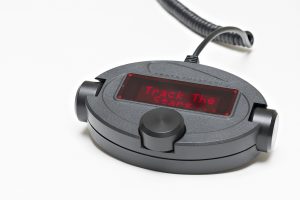
Anyway, night falls, and it’s time to take this baby for a spin.
Aligning to a star or two or three (or planet, or the Sun) is straightforward, and once done, the accuracy of the go-to is great. And with big binoculars, it’s sheer joy. M4? Boom! There it is. Jupiter next. Right in the eyepieces. The Lagoon is rising? Here you go! It’s so quick to use and so easy to look through the binocs with an alt/az, it’s the most fun I’ve had with those big bad boys. Seriously; it’s spectacular. And it’s tracking!

I don’t have to keep nudging that dang object back into view when I’m doing outreach. Everyone can take a gander, and no muss, no fuss, the object’s smackdab in the eyepieces. I even had it sit there for about an hour … no real drift. Whoohooo! And with the Messier, NGC and IC catalogs, there are a lot of objects to choose from.
Now, for imaging (which I didn’t try, but talked to a number of people who have, double-checking their conclusions against one another’s), there’s a rotator that fits right under the scope (Image 4), which is cool and means no polar alignment necessary, and one can control the mount via PC or mobile device (it uses the LX200 protocol and ASCOM drivers). There are backlash settings and ports for a guider (ST4), the hand controller and the optional telescope rotator (Image 5). PE is long and smooth and around 6.0 arcseconds, so, easily guidable.
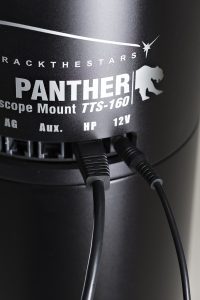
As an all-around mount with great ease of observing – I mean, alt/az is the best for visual: no contortions, no rotations, eyepiece(s) always at the right spot – go-to (yay!), excellent tracking and some nice guiding abilities (no meridian flip folks), this is a superb mount for those who like to do both visual and imaging, but don’t want two separate mounts. It’s the best of both worlds, and its innovative design and easy transport and set up are all pluses.
As a higher-end mount, it does cost more than your basic alt/az sans go-to, as well as some of the medium range equitorial mounts ($5450 visual setup/$6450 astro-photo setup), but it’s well worth it for vigorous use by those who want truly the best of both worlds … and no polar aligning (Image 9).
A thank you to Ed Thomas of Deep Space Products, and Niels Haagh of Track-The-Stars for the use of the mount, and help with any questions I had.
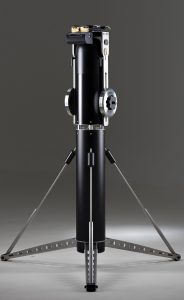
The TTS-160 Panther head is the heart of a highly-configurable mount system (Image 10). Standard configurations include visual observations and long-exposure astrophotography. When in visual-observation mode, the eyepiece remains within comfortable reach, eliminating the physical contortions associated with equatorial mounts. When in astrophotography mode, there is never a need for a meridian flip.
The mount’s unique “Exact Drive” system combines a worm gear and a roller drive to ensure optimal tracking performance with inherently-low periodic error. This system also reduces weight.
All delicate components are sealed inside anodized-aluminum cylinders, to keep contamination and moisture out. The design also protects all sensitive components during transport.
Specifications include:
– Azimuth Drive: 100-mm bronze worm gear combined with a second-stage friction roller gear, spring-loaded for zero backlash.
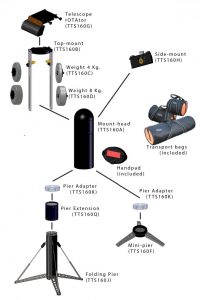 – Altitude Drive: 120-mm spring-loaded bronze worm gear drive.
– Altitude Drive: 120-mm spring-loaded bronze worm gear drive.
– Drive Motors: DC servo motors with high-resolution encoders (0.14 arcsec step size).
– Slew Speed: 3 degrees per second.
– Object Catalogs Installed: Planets, Messier, NGC, IC, Bright Star.
– PC Interface: LX200 and ASCOM; works with all major planetarium and telescope-control software packages.
– Firmware: Internal firmware is stored inside the mount head and can be updated by the user via the PC interface.
– Transport Bag Size: 180-mm (7-inch) diameter, 600-mm (24-inch) length.
To get your own Track-The-Stars (TTS-160) Panther Alt/Az Mount you can visit the product web page here.
 By Mark Zaslove
By Mark Zaslove
A two-time Emmy Award winner and recipient of the coveted Humanitas Prize, Mark is a born-again astro noobie, who once had an Optical Craftsman scope as a kid, and is now recapturing his youthful enthusiasm (with a digital twist) and having a lovely time doing it.
And to make it easier for you to get the most extensive telescope and amateur astronomy related news, articles and reviews that are only available in the magazine pages of Astronomy Technology Today, we are offering a 1 year subscription for only $6! Or, for an even better deal, we are offering 2 years for only $9. Click here to get these deals which only will be available for a very limited time. You can also check out a free sample issue here.


